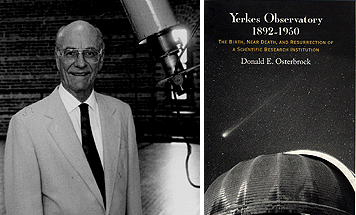
The University of Chicago Magazine
February 1997

Continued
Star Power

It is Donald Osterbrock's own experience as director of a world-class observatory that he says gave him the insights he needed to construct his book Yerkes Observatory, 18921950: The Birth, Near Death, and Resurrection of a Scientific Research Institution, published this winter by the U of C Press. While rich in scientific detail, the book also offers vivid and candid depictions of the strong, sometimes flawed, personalities who combined their energies to make Yerkes the premier astrophysical laboratory in America.
In his introduction, Osterbrock, PhB'48, SB'48, SM'49, PhD'52, admits that "some readers may find a few of my judgments harsh...but I believe it would be false to present a rosy picture in which every decision was the right one, all motives were pure, and all great scientists were also perfect human beings." As a former director of Lick Observatory at the University of California, Santa Cruz, Osterbrock notes, "I can see myself all too clearly in some of their less noble actions, taken, they believed, from the highest motives....Henrik Ibsen's words, 'To write--that is to hold judgment over one's self,' very definitely apply to this book."
Although his book is written in conjunction with Yerkes' 1997 centennial, Osterbrock focuses on the observatory's pre-1950 history, presided over by three very different directors: "George Ellery Hale, who built Yerkes Observatory, Edwin B. Frost, who let it decay, and Otto Struve, who revived it." Osterbrock took classes from Struve in the U of C astronomy department during the 1940s and '50s, and his account of Struve's brilliant rise in and acrimonious departure from the observatory make some of the book's most compelling chapters.
Struve represented the fourth generation of one of Russia's great astronomical families; his father was director of the Kharkov Observatory, but was removed from office by the Bolsheviks and died soon after. Struve, who had served in the White Army, took refuge in a relief camp in Turkey. When Edwin Frost heard of his plight, he pulled strings through his wealthy contacts in Chicago to have the young man brought to Yerkes in 1921, and Struve almost immediately began doing outstanding research for the observatory.
Hiring Struve turned out to be among the few positive legacies of Frost's tenure, which lasted until he was more or less forced to retire and Struve was made director in 1932. Through cultivation of promising young Ph.D. students, his appointments of soon-to-be legendary astronomer-astrophysicists (Gerard Kuiper, Bengt Strömgren, and Subrahmanyan Chandrasekhar), and his ability to win unwavering support from U of C President Robert Maynard Hutchins, Struve succeeded in regaining national prominence for Yerkes, launching what many regard as the observatory's golden era.
Despite this success, Struve eventually fell from favor at Yerkes, in part because of his expectations that the observatory's rising stars obediently follow his lead instead of pursuing their own interests. Still, a conflict of some sort was inevitable, for the expectation at that time was for an observatory director to "keep his post until he retired or died. The only way to get rid of a living director," writes Osterbrock, "was through what seemed to the outside world like a knockdown fight."
Such tales of power struggles, professional jealousies, and political intrigue give Yerkes Observatory, 18921950, a surprisingly dramatic punch. Yet Osterbrock presents even these darker moments with compassionate insight. In the final chapter, he notes that Edwin Frost, though he may not be remembered in the annals of scientific history, "was a warm, friendly person, honored and respected by the citizens of Williams Bay and Lake Geneva." Though "there is no Hale Street or Struve Avenue...there are a Frost House, Frost Woods, Frost Park, Frost Drive, and Frost Circle in present-day Williams Bay."
"Frost died in Billings Hospital surrounded by his wife and children; Struve, childless, died alone in a hospital in Berkeley. Which," the astronomer leaves his readers to decide, "was better?"--Timothy A.Obbermiller
Return to opening of "ASTRONOMICAL FIGURES"
Go to:
- INVESTIGATIONS
- CHICAGO JOURNAL
- EVENTS
- LETTERS
- CHICAGOPHILE
- Feature story, "LIFE SUPPORT"
- Feature story, "Brushes with perfection"
- Feature story, "Opening Chapters"
- Feature story, "Astronomical Figures"
- CLASS NEWS
- DEATHS
- BOOKS BY ALUMNI
- IN THE CLUBS
Return to February 1997 Table of Contents